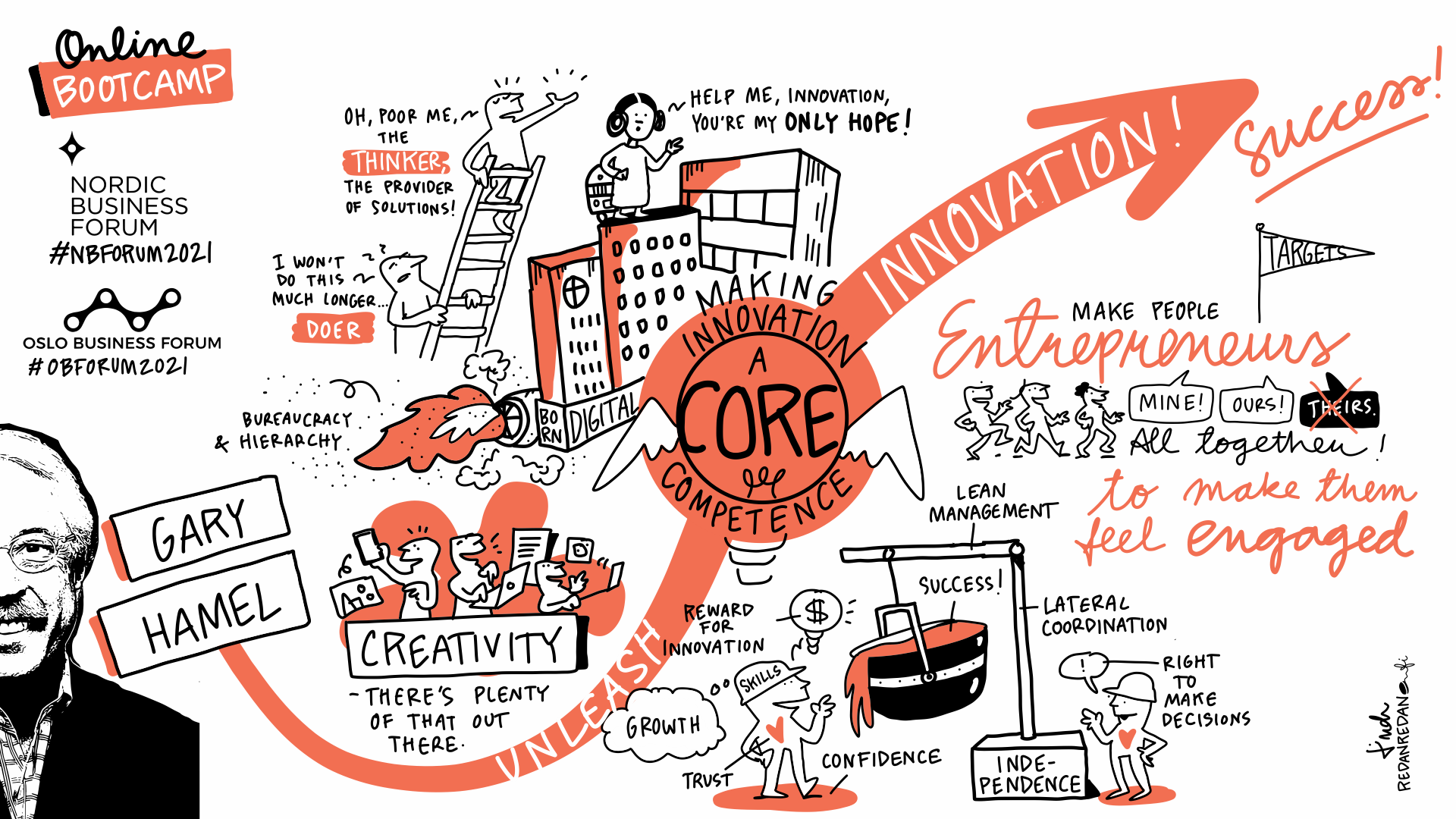“There’s no logic today at all for any organization to have more than 2 or 3 layers.”
Gary Hamel is a highly influential business thinker and speaker. He has been on the faculty of the London Business School for over three decades and is the director of the Management Lab. Gary is the most reprinted author in the history of Harvard Business Review and has contributed 17 articles to date. He is a notable author with recent titles, including The Future of Management and What Matters Now.
Gary has introduced a variety of groundbreaking concepts into the business world including, "strategic intent," "core competence," and "management innovation," which are changing the words and practices of management globally.
At the bootcamp, Gary shared his ideas on how to make innovation a core competence in an organization.
.jpg?width=3000&name=MaxEmanuelson__MAX6306%20(1).jpg)
The Role of Innovation
Cutting right to the chase, Gary stated that despite all of the debate about innovation in the last decade, companies have not cracked it yet. He has worked with some of the world's largest and most innovative companies to discover how they have unleashed the creativity and passion that exists within their workforces.
Gary highlighted that innovation is the most critical competitive advantage in today's business world. Across any industry, innovation is the only antidote to commoditization, the only insurance against irrelevance in a world of relentless change, and the only guarantee of customer loyalty.
Overall, Gary believes innovation is the only hope for humanity in dealing with the extraordinary challenges we face, such as climate change, stagnant economies, global pandemics, and the threat of automation. There is no time to lose in our response to these issues. Gary noted that Elon Musk articulated this well when he said, “What matters is the pace of innovation. That is the fundamental determinant of competitiveness.”
The Innovation Problem
Next, Gary highlighted a critical problem facing organizations. While 79% of CEOs believe innovation is a top priority, 94% believe their organizations are not good enough at innovating. That's a huge gap.
To prove his point, Gary shared a well-known list of the world's most innovative companies. Looking through the list across years, it was clear that the companies were predominantly start-ups and young digital-first businesses. What's more, the companies only managed to stay on those lists for a year or two, having lost their entrepreneurial energy. The notable exception is (surprise, surprise) Tesla.
Gary then shared his perspective on the statistics. He argued that this is not a problem of human creativity; for example, consider all the content shared on social media every day. The problem is that not much of this creativity is showing up at work. The cold, hard truth is that we built our organizations to maximize compliance and not innovation. Our initiatives at the margin, such as incubators, are insufficient to improve innovation performance in this structure. So, Gary argued that we must go right down to the organization's DNA and challenge the bureaucracy to turn on the creative capacity of every single employee.
Bureaucracy Kills Innovation
Gary took us back to the work of Max Weber, who saw bureaucracy as the superior form of organization for precision, stability, discipline, and reliability. Gary noted that while these factors are important, they are no longer enough to differentiate companies.
In essence, bureaucracy is a combination of military command structures - the pyramid - and industrial engineering principles, which questioned how to do more with less. Gary noted that the bureaucracy empowers the few at the cost of the many. The “thinkers” sit at the top of the organization and “doers” at the bottom, creating lags in response times throughout the firm. Gary shared that the average large organization now has seven or eight layers in it, while he recommends a maximum of two or three. “There’s no logic today at all for any organization to have more than 2 or 3 layers.”
According to Gary, leaders are learning a new definition of hopelessness - trying to compete in a networked world with a hierarchical organization. Here employees are not competing to add value; they are pursuing the scarce opportunities for promotion, leading to negative behaviors which don’t support innovation.
Gary further explained that many thought leaders have presented a firm's size as a trade-off to its level of innovation. He, however, disagreed with this theory. While bureaucracy is a barrier to innovation, we can rethink the fundamentals of management to build the spirit of entrepreneurship within every company. Gary then presented insights into two companies that have succeeded in achieving precisely that.
Nucor
Nucor is a highly profitable and innovative steel company. It has managed to turn on the brainpower of every employee. Gary cited the example of significant building works in which the frontline employees designed and sourced a solution that was one-tenth of the price that another tender exercise had found. That is just one example of their daily ingenuity. Nucor views its employees as the source of its genius, and employees show management how to reach goals.
The company comprises 75 independent businesses, each with an individual P&L, with zero allocations from central structures. The local team is fully responsible for their success. There is a lean management structure with just a centralized finance team, and everything else sits at the independent business level. Frontline employees have budget responsibility and decision-making rights, enabling blue-collar workers to feel that Nucor is their business. There are significant rewards for innovations that increase productivity, and workers receive bonus payments a week after the productivity-increasing activity. With bonuses, they enjoy remuneration that is 25 to 50% higher than the industry average.
Gary explained that every Nucor employee is accountable for growth and has a financial stake in it. Management pushes confidence down to the frontline by training everyone in the economics of the steel industry. They want every employee to have the wisdom and skills to exercise their decision-making authority wisely. Employees see data on every plant so they can learn from each other and share successes. Plants can coordinate together without needing head office intervention. They have a chain of trust rather than a chain of command, supported by jobs for life.
The former chairman and CEO of Nucor, Ken Iverson, put well into words the idea behind the company’s philosophy: “Most of today’s corporations were conceived as command and control organizations. In contrast, we built Nucor under the assumption that most of the ‘genius’ in our organization would found among the people doing the work. From the outset, we shaped our business to let employees show management the way to goals that once seemed unreachable.”
.jpg?width=3000&name=MaxEmanuelson__MAX6318%20(1).jpg)
Haier
Haier is the world's leading appliance maker and one of the leaders in the internet of things.
Gary explained that the firm has a forward-thinking management model based on encouraging employees to become entrepreneurs. Zhang Ruimin, the CEO of Haier, has said: “We encourage employees to become entrepreneurs because people are not a means to and end, but an end in themselves. Our goal is to let everyone become their own CEO.”
Haier took an organization of fifty thousand people with seven managerial layers and got rid of twelve thousand middle managers. They reassigned the managers into micro-enterprises, each with 15 to 20 employees, and did the same with functions such as HR.
Each micro-enterprise has ambitious leading targets with individual compensation linked to those targets. The whole company is tied together through internal contracting with success measures based on the marketplace results.
In addition, each micro-enterprise can choose to contract with services inside or outside of the business to ensure competitiveness. These micro-enterprises can also take on larger contracts through internal contracting and collaboration to increase scale.
Gary highlighted that all innovation at Haier results from dialogue with the end-user. Every employee can be an owner of their micro-enterprise, and their success record s
peaks for itself with 3 IPOs and 11 unicorns, and 4,000 start-ups so far.

Seven Steps to Unleashing Innovation
“The recipe book for unleashing innovation is not that complicated.” So, to conclude, Gary shared seven steps to unleashing innovation:
- Flatten the pyramid.
- Break big units into small ones.
- Teach everyone to think like a business person.
- Give frontline teams a genuine P&L, not top-down targets.
- Encourage relentless experimentation.
- Give every employee a financial upside.
- Treat every job as essential to success.
At the end of his session, Gary emphasized that implementing these steps unleashes a torrent of innovation capacity and builds an organization that can win against the competition.
Key Points
- There is a considerable innovation gap. 79% of CEOs believe it is important, and yet 94% think their firm is not good enough at innovating.
- The typical bureaucratic organization structure stifles creativity and innovation while delivering insufficient competitive advantage in today's marketplace.
- There is enough creativity in the world to drive innovation. Organizations must go to the heart of their DNA to unlock it in their people.
- Gary gave seven steps for organizations to unleash innovation.
Questions to Consider
- How does your organization perform against Gary’s seven steps for unleashing innovation?
- What best practices can you embed from leading companies such as Nucor and Haier?
- What action will you take to embed innovation within your firm’s DNA?
